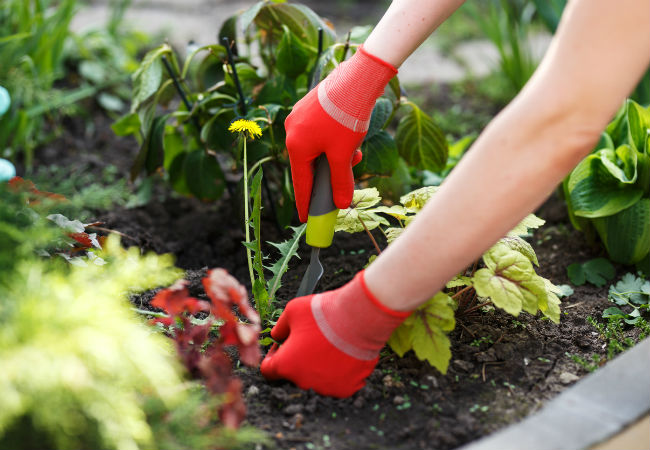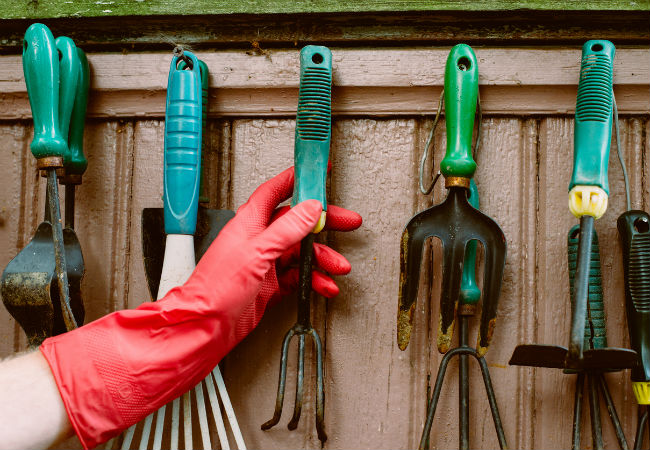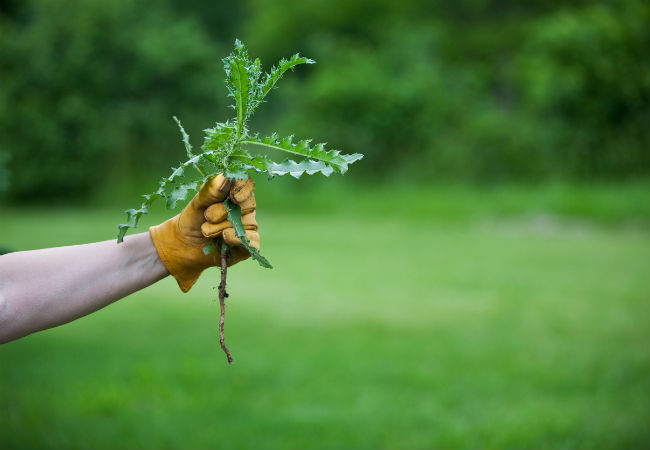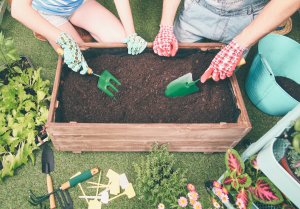We may earn revenue from the products available on this page and participate in affiliate programs. Learn More ›
Ask any group of gardeners about their least favorite task, and you’re bound to hear a chorus of “Weeding!” Rampant weeds steal water and valuable nutrients from the soil that beneficial plants could be receiving, and their less-than-lovely presence detracts from lawn and garden design.
Maintaining an entirely weed-free garden and landscape might not be possible, but by addressing problems promptly and taking steps to reduce future weed growth, you can lessen the time spent weeding. Ahead, learn how to deal with weeds and find out which tools and products make the task simpler.
How to Remove Weeds From Your Lawn and Garden
In your quest to keep the landscape weed-free, it’s easy to make some overzealous mistakes. Before trying your hand at getting rid of weeds, read on for the right way to vanquish the green invaders and reduce their future growth. A bountiful vegetable harvest, big beautiful flowers, and more time to relax will be the happy result.
Don’t wait to weed.
If you let weeds tower over your tomatoes, you’ll have a tough time removing them. When weeds are small their roots are weaker, making it easier to pull them out. Commit to doing a quick walk-through of your garden every other day; it will take only a few minutes to pull up any young weeds that show up.
Weed when the soil is wet and soft.

Pull weeds soon after watering your plants or a rain shower; when the soil is moist, the whole weed is more likely to come out by the roots. It’s fine to put pulled weeds in your compost bin, where the naturally hot temperatures should destroy any seeds.
It’s also easier to pull weeds if the soil is healthy, soft, and loamy. Well-drained soil is light in weight and doesn’t compact, making it physically easier to pull weeds out by their roots. On the other hand, dense and compressed soils, such as those heavy in clay, lock roots in place, making it difficult to pull anything but the smallest weeds.
The addition of organic matter such as compost and dried leaves will help lighten and loosen garden soil over time. Try adding an inch or two to the surface of the planting bed every spring and working it in with a shovel. Adding organic matter makes weed-pulling easier and offers a healthier growing environment for desirable plants.
Grab weeds at the base and pull them out by the roots.
Gardeners who weed manually might be tempted to reach down and snatch a handful of leaves and give them a sharp tug. Unfortunately, that often causes the weed to snap in two, leaving the bottom half and the roots still in the ground. Instead, take your time and grab each weed individually at its base and then pull slowly and steadily to ease the roots from the soil.

Wield the proper tools.
Many gardeners find that a few good weeding tools help get to roots or speed up the task. Choose well-made implements with solid handles that are comfortable to grasp, and look for those that have heads or blades made of tough forged steel.
The trick is to figure out how to pull weeds without pulling a back muscle. Bending over while standing can strain the back, which is why investing in tools you can use while kneeling or standing (see chart below) are well worth the expense.
BV's Favorite Tools for Pulling Weeds
Kneeling tools
These tools have relatively short handles, from about 6 to 12 inches long, and are used while kneeling in the garden.
- Rake-type tools with finger-like prongs—the TOYPOPOR Gardener’s Claw Rake is a good one—work well for scraping up surface weeds with minimal root systems, such as henbit.
- A hook neck tool, such as the CobraHead Weeder, can be positioned behind the base of a weed and used to dig in and scoop out the intruder.
- To remove weeds between beneficial plants, try an angled hand hoe like the Tomerry Nejiri Gama Hoe, which features a sharp point for getting into tight spots. Hand shovels can be used to dig out large weed roots.
Standing tools
Long-handled tools enable you to remain standing during your weed-removal chores.
- A hoe with a sharpened blade, such as the Truper Tru Pro 60-Inch Hoe, can sever roots beneath the soil surface with a single chop.
- Grip-and-pull weeders like the CobraHead Long Handle Weeder and Cultivator promise to save time and labor when removing weeds with deep root systems, such as dandelions.
- The Fiskars 4-Claw Stand Up Weeder, the top pick in our guide to the best stand-up weeders, has an ergonomic handle and a lifetime warranty.
Kill weeds with heat.
To deal with a large swath of weeds that don’t respond to other methods, consider burning them out. A weed burner (also known as a weed torch), such as the Flame King Propane Weed Burner, connects to a standard propane tank to deliver a flame directly to the weeds, scorching and killing them. It’s one of the best ways to remove weeds from a large area. A weed burner works well on invaders growing beneath fences or encroaching near raised garden beds, although you’ll want to take care around wooden structures.
Be sure weeds are green, not brown and dry. When removing weeds, you want to scorch them, not start a fire. Check with local authorities before using a torch for weed control as some communities might restrict or ban their use.
Hot water can also weaken weeds. Carefully pour a pitcher of just-boiled water directly on weeds, taking care not to splash scalding water on your feet.
You also can generate weed-killing heat using plastic. After harvest in fall, cover a planting bed with dark landscape plastic (hold it in place with rocks or bricks) and leave it on over the winter. Sun hitting the plastic will heat up the soil temperature beneath to destroy weed seeds.
Weigh the advantages and disadvantages of using herbicides for weed removal.
Need a break from the strenuous work of pulling weeds? Controlling these unwanted crops with foliar herbicides (toxic substances absorbed through a plant’s leaves) is physically easier than either pulling or hoeing. Before you apply these weed killers, we recommend trying manual and natural methods first. For example, consider a nontoxic herbicide, such as Natural Armor Weed And Grass Killer, which will avoid the contamination problems associated with toxic herbicides. Then, research the effects of herbicides carefully, and use them only as a last resort.
| Pros | Cons |
| Spraying a foliar herbicide such as Green Gobbler Vinegar Weed and Grass Killer kills individual weeds or large areas that are awash with weeds. | The wind could blow herbicidal spray onto the other plants in your yard—the ones you don’t want to get rid of—inadvertently harming or killing them. |
| Foliar herbicides work quickly, killing weeds sometimes within a day—and usually no longer than a week. | Exposure to chemical herbicides may result in skin irritation, while inhaling the spray can result in a sore throat and other respiratory woes. Always take steps to prevent contact with the spray. |
| There’s no need to remove weeds individually and no strain on your back from bending over and pulling weeds for long periods. | Weeds that are chemically killed should not be placed in the compost bin. Traces of herbicides can survive the composting process and stunt vegetation if later used in garden soil. |
| Chemical herbicides may interfere with the environment, and studies indicate that the chemicals can affect earthworms and offset soil nutrients, leading to the leaching of chemicals into streams and underground aquifers. |
How to Prevent Weeds
Optimally, of course, you wouldn’t have any weeds to pull. There are a few steps you can take to minimize and maybe even inhibit the growth of weeds in the first place.
Keep weed seeds from germinating.
Consider a pre-emergent herbicide to keep weed seeds from germinating. Sprinkle a granular pre-emergent herbicide such as Preen Vegetable Garden Natural Weed Preventer on the soil and then water. The granules will dissolve and the ingredients will permeate the soil, creating a barrier around the weed seeds. A single application will last about 4 to 6 weeks, after which the product can be reapplied.
Note that once a pre-emergent is in the soil, beneficial seeds won’t sprout either. For best results, wait until beneficial plants, such as flowers, tomatoes, and cucumbers, are 4 to 8 inches tall before using a pre-emergent product (as directed on the package)—it won’t kill plants that are already growing.
Another way to keep weed seeds from germinating is to not disturb them. Actions like digging, turning the soil, and ripping up existing plants and weeds often trigger germination of weed seeds that were lying dormant. It’s a catch-22 because you have to disturb the soil to remove weeds, but you might cause more weed seeds to sprout when you do. The weeds have to go, but try to disturb the soil as little as possible when getting rid of them.
Lay some landscape fabric.

Reduce the number of weeds in perennial flowerbeds and borders by using landscape fabric. Available in large rolls for spreading out around shrubs, roses, trees, and bushes, landscape fabric stops weeds from growing by creating a barrier that doesn’t let the sunlight reach them. While various types of landscape fabric are available, most are made from woven materials such as polypropylene and contain perforations that allow water to seep through.
Landscape fabric is designed to be used with a surface mulch such as wood chips, rubber bits, or pine needles that hold the mulch in place. While the fabric reduces weed growth without using chemical herbicides, the downside is that it discourages garden-friendly earthworms from aerating the soil because they can’t reach the surface.
Grow a no-till garden.
Every fall and again every spring, home gardeners can be found turning their garden soil to help break up heavy clay, distribute organic matter, and deliver oxygen to the soil. Tilling in this way also brings dormant weed seeds to the surface, where they quickly sprout. An alternative to turning the ground several times annually is a no-till garden, which reduces the need for weeding tools.
Tilling is necessary only once, in early spring to loosen the soil. After that, cover the garden with 4 to 6 inches of organic mulch (dried leaves, grass clippings, or hardwood chips). The mulch helps keep the soil beneath moist and prevents weed seeds from sprouting by keeping light from reaching the soil’s surface. When it’s time to plant seeds or transplant seedlings, just push the mulch aside in that spot.
Final Thoughts
Battling weeds is an ongoing issue for growers everywhere, and in many cases, a multi-pronged approach to getting rid of them is the best practice. By pulling weeds when they’re small, you attack them while they’re simpler to remove and before they get a chance to bloom and go to seed, which could significantly increase weed problems. Being conscientious in early weed removal and preventing weeds also reduces the need to use chemical herbicides that are not healthy for the environment.
FAQs
The eco-friendliest option is to add pulled weeds to a compost pile or bin where the internal temperature will reach at least 145 degrees Fahrenheit to kill the weed seeds. The finished compost can then be cycled back to the garden to add nutrients to the soil.
Weeds will always be with us, but they can be reduced to a manageable number by following good gardening techniques. This includes pulling weeds when they’re small, using a barrier such as landscape fabric, applying a pre-emergent herbicide to the soil around beneficial plants, or practicing no-till gardening.
The best way to get rid of weeds is to pull them as soon as they sprout. This may require spending 5 to 10 minutes daily or every other day pulling tiny weeds, but it’s much simpler to remove them while they’re small.
A standard garden hoe is the best all-around weeding tool because it can be used to remove small weeds without the need to bend over or kneel on the ground.
Perennial daisies spread by rhizomes (underground stems), and while they’re prized in the flowerbed, they can be a nuisance when they pop up in the lawn. You can dig the individual plants up, making sure to get all the rhizomes. Alternatively, apply a non-selective chemical herbicide directly to the daisy’s leaves to kill the plant.


